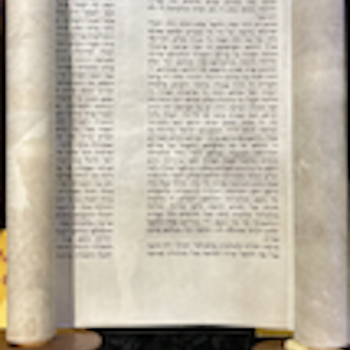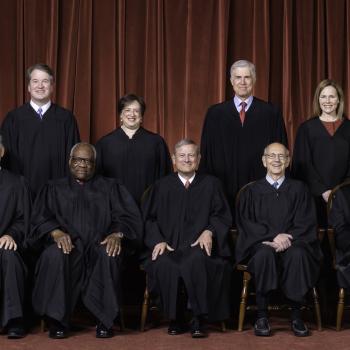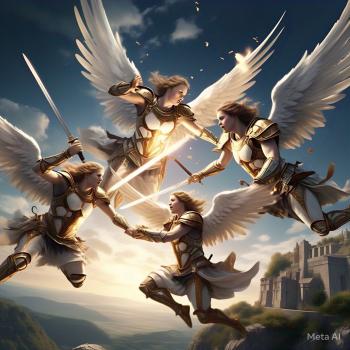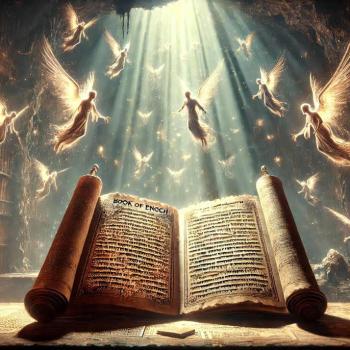Paul’s Eschatology in 2 Thessalonians
Jesus seems to have derived much of his concept about the kingdom of God from the apocalyptic book of Daniel.[1] He says in his very prophetic Olivet Discourse concerning the temple at Jerusalem, “when you see standing in the holy place the abomination that causes desolation, spoken through Daniel the prophet . . . let those who are in Judea flee to the mountains. . . . For then will be great distress, unequaled from the beginning of the world until now—and never to be equaled again” (Mt 24.15-16, 21 NIV). Daniel further says of that time that the Antichrist, symbolized as a little horn, “was waging war against the saints and defeating them, . . . The saints will be handed over to him for a time, times and half a time,” which means three and a half years (Dan 7.21, 25 NIV; cf. v. 8).[2] And an angel tells Daniel that after that, “the shattering of the power of the holy people comes to an end” (Dan 12.7). That is why Jesus also said in his Olivet Discourse, “the one who endures to the end will be saved” (Mt 24.13). For, such great tribulation will cause some to abandon their pseudo-faith.
Thus, after Paul’s salutation in his second letter to the Thessalonians, he mentions their “steadfastness and faith during all your persecutions and the afflictions that you are enduring” (2 Thes 1.4). Then he reminds them of the future, “when the Lord Jesus is revealed from heaven with his mighty angels in flaming fire, inflicting vengeance on those who do not know God . . . These will suffer the punishment of eternal destruction, . . . when he comes to be glorified by his saints and to be marveled at on that day among all who have believed” (vv. 7-10). Jesus seems to have been a pacifist at his first coming; but due to the great persecution and martyrdom that his people will suffer in the end times, he will be a delivering warrior at his second coming.[3]
In saying that Jesus will return with his “mighty angels in flaming fire,” Paul seems to indicate it will be a most dramatic affair that no believer, at least, will fail to witness with awe. Likewise, the author of the book of Revelation combines two texts, Dan 7.13 and Zech 12.10, in saying of Jesus’ return, “Look! He is coming with the clouds; every eye will see him, even those who pierced him; and on his account all the tribes of the earth will wail” (Rev 1.7).
So, Jesus’ second coming will not be a gradual, spiritual process in which the church will Christianize the world as many Christians have believed in the past. For, when Jesus ascended to heaven before his disciples on the Mount of Olives, two angels appeared to them and declared, “Men of Galilee, why do you stand looking up toward heaven? This Jesus, who has been taken up from you into heaven, will come in the same way as you saw him go into heaven” (Ac 1.11).
Jesus himself predicted literally regarding his return, “Immediately after the suffering of those days the sun will be darkened, and the moon will not give its light; the stars will fall from heaven, and the powers of heaven will be shaken. Then the sign of the Son of Man [Jesus] will appear in heaven, and then all the tribes of the earth will mourn, and they will see the Son of Man coming on the clouds of heaven with power and great glory” (Mt 24.29-30). So, Jesus’ return will be an instantaneous, cataclysmic event involving all of creation.
Paul then reminds these Thessalonians of what he had taught them and written in 1 Thes 4.13-17 about the future gathering of resurrected and living believers into the sky to meet Jesus at his return. Paul writes here, “As to the coming of our Lord Jesus Christ and our being gathered together to him, we beg you, brothers and sisters, not to be quickly shaken in mind or alarmed, either by spirit or by word or by letter, as though from us, to the effect that the day of the Lord is already here” (2 Thes 2.1-2). Paul seems to imply that another false teaching had been circulating among some Christian communities which asserted that Jesus had already returned.
About twelve years after this, Paul wrote 1 Timothy. Therein, he says, “Fight the good fight, having faith and a good conscience. By rejecting conscience, certain persons have suffered shipwreck in the faith; among them are Hymenaeus and Alexander, whom I have turned over to Satan, so that they may learn not to blaspheme” (1 Tim 1.18-20). Paul doesn’t identify the error.
About three years after that, Paul wrote 2 Timothy wherein he mentions these false teachers again. He says, “Among them are Hymenaeus and Philetus, who have swerved from the truth by claiming that the resurrection has already taken place. They are upsetting the faith of some” (2 Tim 2.17-18). So, Paul may have had this error in mind when he wrote 2 Thes 2.1-2.
Paul continues in 2 Thessalonians, “Let no one deceive you in any way; for that day will not come unless the rebellion comes first and the lawless one is revealed, the one destined for destruction” (2 Thes 2.3). The last prepositional phrase in the Greek text means literally “son of perdition” (KJV). “Rebellion” translates apostasia, which means a “falling away” (KJV) from faith and righteousness. “Lawless one,” literally “man of lawlessness,” identifies the Antichrist.
Apparently, the term “antichrist” originated sometime after Paul wrote his two letters to the church at Thessalonica. For, “antichrist” appears only four times in the New Testament, all in the Johannine epistles (1 Jn 2.18, 22; 4.3; 2 Jn 1.7), which were written later.
By mentioning rebellion and lawless one, plus in that order, Paul alludes to Dan 8.23. It says, “when the transgressions have reached their full measure, a king of bold countenance shall arise.” So, this rebellion will prepare the way for this king to emerge who will be the Antichrist. But most scholars claim this refers only to Antiochus IV who plundered Israel in the second century BCE. That might have been correct if Israel would have repented in the first century CE and the end have come then. But since that didn’t happen, Antiochus only partially fulfills this prediction of a bold king, being a forerunner of the Antichrist who will fulfill it completely.
For Paul to say that the great rebellion and the appearance of the Antichrist must occur before Jesus returns also indicates that his return was neither imminent then nor now, meaning it could not occur at any moment as pretribulationists assert of the rapture. And this also suggests that those scholars err who claim certain New Testament texts indicate an imminent parousia (“presence,” referring to Jesus’ return).
Paul continues in 2 Thessalonians concerning the Antichrist by saying, “He opposes and exalts himself above every so-called god or object of worship, so that he takes his seat in the temple of God, declaring himself to be God” (2 Thes 2.4). All English versions have this last word, here, as “God.” In the Greek New Testament, the word for either “god” or “God” is theos. When Bible documents were written, Hebrew and Greek did not have capitalization. So, when Bibles have a capitalized word that is not a proper name, that is an assessment that translators make often on the basis of context, but occasionally in comparing scripture with scripture.
2 Thessalonians 2.4 has three occurrences of theos in the Greek text. Translators well translate the first theos as “god.” And they rightly capitalize the second theos as “God” since Paul refers to the temple at Jerusalem. But it is incorrect to translate the third theos as “God.”
First, the second theos in 2 Thes 2.4 has the article, whereas the first and third theos are anarthrous, meaning without the article. Usually in the Greek New Testament, but not always, theos with the article refers to “God,” whereas theos with no article is translated “god” or “a god.” So, the last clause in 2 Thes 2.4 likely should say the Antichrist will declare himself to be “a god.”
Second, regarding the last theos in 2 Thes 2.4, we have the benefit of comparing scripture with scripture. For, Paul alludes therein to the book of Daniel again, to Dan 11.36. It says of the Antichrist, “The king shall act as he pleases. He shall exalt himself and consider himself greater than any god, and shall speak horrendous things against the God of gods.” So, the Antichrist will not claim to be God; rather, he will recognize God and speak blasphemy against him. Daniel has informed about this by saying of his first mention of the little horn, the Antichrist, “He shall speak words against the Most High” (Dan 7.25), referring to God. And King Nebuchadnezzar told Daniel, “Truly, your God is God of gods and Lord of kings” (Dan 2.47).
Third, the book of Revelation says of the Antichrist, who is depicted as a beast, “It opened its mouth to utter blasphemies against God, blaspheming his name and his dwelling” (Rev 13.6; cf. 16.9-11). So, the Antichrist will believe God exists and not claim to be God.
Paul then writes, “Do you not remember that I told you these things when I was still with you?” (2 Thes 2.5). Indeed, Paul likely taught them from the book of Daniel.
Paul writes next, “you know what is now restraining him,” referring to the Antichrist, “so that he may be revealed when his time comes” (v. 6). The last clause indicates that God has appointed an exact time when the Antichrist will appear (cf. Dan 8.19; 11.27, 29, 35). Paul had taught them what the restraining was; but we are not so informed.
Paul then writes, “For the mystery of lawlessness is already at work, but only until the one who now restrains it is removed” (2 Thes 2.7). To what does this restraining (Gr. katechon) refer? Scholars generally have interpreted the restraining in v. 6 as an inanimate power and the restraining in v. 7 as a person since it has a pronoun whereas the first restraining does not.
Since Paul has taught them about the rebellion and the Antichrist by alluding to two texts in Daniel, it seems prudent that we search Daniel about this restraining as well, as if Paul alludes to it there. Indeed, some ante-Nicene church fathers did just that, and F. F. Bruce cites them.[4]
Irenaeus (c. 130-c. 202 CE) refers to the ten toes of the image in Daniel 2 and the ten horns of the fourth beast in Daniel 7 when he admonishes the church to “wait, in the first place, the division of the kingdom into ten; then, in the next place, when these kings are reigning, . . . to acknowledge that he who shall come claiming the kingdom for himself,” referring to Antichrist.[5]
Tertullian (c. 155-c. 220 CE) goes into greater detail. But he confuses matters by saying of 2 Thes 2.3, “‘For that day shall not come, unless there first come a falling away,’ he means indeed of this present empire,” namely, the Roman Empire. On the contrary, Paul means a falling away from righteousness. Tertullian then rightly says of 2 Thes 2.3, “‘and that man of sin be revealed,’ that is to say, Antichrist.” Tertullian then quotes Paul about the restraining in v. 6 and says of it, “What obstacle is there but the Roman state, the falling away of which, by being scattered into ten kingdoms, shall introduce Antichrist.”[6] Despite Tertullian’s error in identifying the falling away, I think these two church fathers are on to something about the Roman Empire.
John Chrysostom (c. 347-407) was too. He says of the identity of the restrainer in 2 Thes 2.6-7, “Some indeed say, the grace of the Spirit, but others the Roman empire.” He argues convincingly that the restrainer is not the Holy Spirit because Paul could have easily said so. Chrysostom claims Paul writes this “obscurely” to avoid upsetting Roman authorities. But I think he does so because it is a complexity that cannot be stated in short compass. Then Chrysostom quotes v. 7 and says, “‘Only there is one that restraineth now, until he be taken out of the way,’ that is, the Roman empire is taken out of the way, then he [the Antichrist] shall come.”[7]
It does not make good sense that either the Holy Spirit or the Roman Empire will be “taken out of the way” (KJV, NASB, NIV) or “removed” (NRSV) in order for the Antichrist to appear. The Holy Spirit surely will continue to minister in the end times. And according to Daniel 7, the fourth beast, which symbolizes the Roman Empire, will exist to the end.
I believe there is a four-fold intertextuality in 2 Thes 2.3-8 that Bible translators and interpreters miss. We have seen that in v. 3 Paul alludes to Dan 8.23, and in v. 4 he alludes to Dan 11.36. I think Paul alludes to the book of Daniel again about this restraining. Therefore, heos ek mesou genetai in the Greek text of 2 Thes 2.7, which is usually translated “until he/it is taken out of the way” or “removed,” should be translated “until it comes out of the midst.”[8]
This translation of the last clause in 2 Thes 2.7 indicates that Paul alludes to Dan 7.8a. It says in the NRSV, “I was considering the horns, when another horn appeared, a little one, coming up among them.” This reads in the LXX (Old Greek) version, “Poosenooun tois kepasin autou, kai idou kepas heteron mikron anebe en meso auton. Benton’s translation of the LXX renders it, “I noticed his horns, and, behold, another little horn came up in the midst of them.”[9] Notice that the LXX has the word mesos—meaning “midst,” “middle,” or “among”—just as Paul has in 2 Thes 2.7. This use of the same word in both texts further indicates that Paul refers to the little horn rising out of the midst of the ten horns. Thus, the Roman Empire and the necessity of the ten kings is what restrains this lawless one, the Antichrist, from coming into existence. And both Greek verbs, anabaino in Dan 7.8a and ginomai in 2 Thes 2.7, mean “arise” or “come up.” It is due to this complexity that Paul reminded them of this so briefly.
So, from our viewpoint in the 21st century, there must be a future revival of the Roman Empire. I believe it will be located in all of Europe, the Middle East, and North Africa.[10] It will be governed by ten kings who will rule ten kingdoms. Apostasy will have been increasing, perhaps over a lengthy period of time. Then the Antichrist will arise to become the emperor of the whole empire. The book of Revelation says of him and a ten-horned beast that symbolizes the Roman Empire, “the ten horns that you saw are ten kings, who have not yet received a kingdom, but they are to receive authority as kings for one hour together with the beast. These are united in yielding their power and authority to the beast; they will make war on the Lamb, and the Lamb will conquer them, for he is Lord of lords and King of kings” (Rev 17.12-14).
Similarly, Paul’s fourth allusion in 2 Thes 2.3-8 to an Old Testament text is Isa 11.4, to which all Bible students agree. He writes to the Thessalonians, “And then the lawless one will be revealed, whom the Lord Jesus will destroy with the breath of his mouth, annihilating him by the manifestation of his coming” (2 Thes 2.8). Isaiah says of Messiah, “he shall strike the earth with the rod of his mouth, and with the breath of his lips he shall kill the wicked [one]” (Isa 11.4).
To sum, Paul’s corpus reflects the constant New Testament portrayal that at the end of the age Jesus will return, raise the dead, vanquish his enemies including the Antichrist, conduct the judgment, and establish his worldwide kingdom of peace, justice, and righteousness forever.
[1] The concept of the kingdom of God appears 14x in Daniel and rarely in the rest of the Old Testament.
[2] This 3.5 years is stated variously in Dan 7.25; 12.7; Rev 12.6, 14; 13.5; cf. 11.3.
[3] See still here Book 2: Warrior from Heaven.
[4] F. F. Bruce, 1 & 2 Thessalonians, WBC45 (Nashville: Thomas Nelson, 1982), 171, 184-86.
[5] Irenaeus, Against Heresies, 5.30.2. Italics his.
[6] Tertullian, “On the Resurrection of the Flesh, ANF, vol. 3, 24. [get this ref. right]
[7] John Chrysostom, “Homily IV on 2 Thessalonians,” in NPNF, vol. 13.
[8] This is how it is translated in Alfred Marshall’s The Interlinear Greek-English New Testament.
[9] Sir Lancelot C. L. Benton, The Septuagint with Apocrypha: Greek and English (orig. 1851; rep. Peabody, MA: Hendrickson, 1986).
[10] See pp. 5-7, which includes a map, in still here Book 2: Warrior from Heaven.














